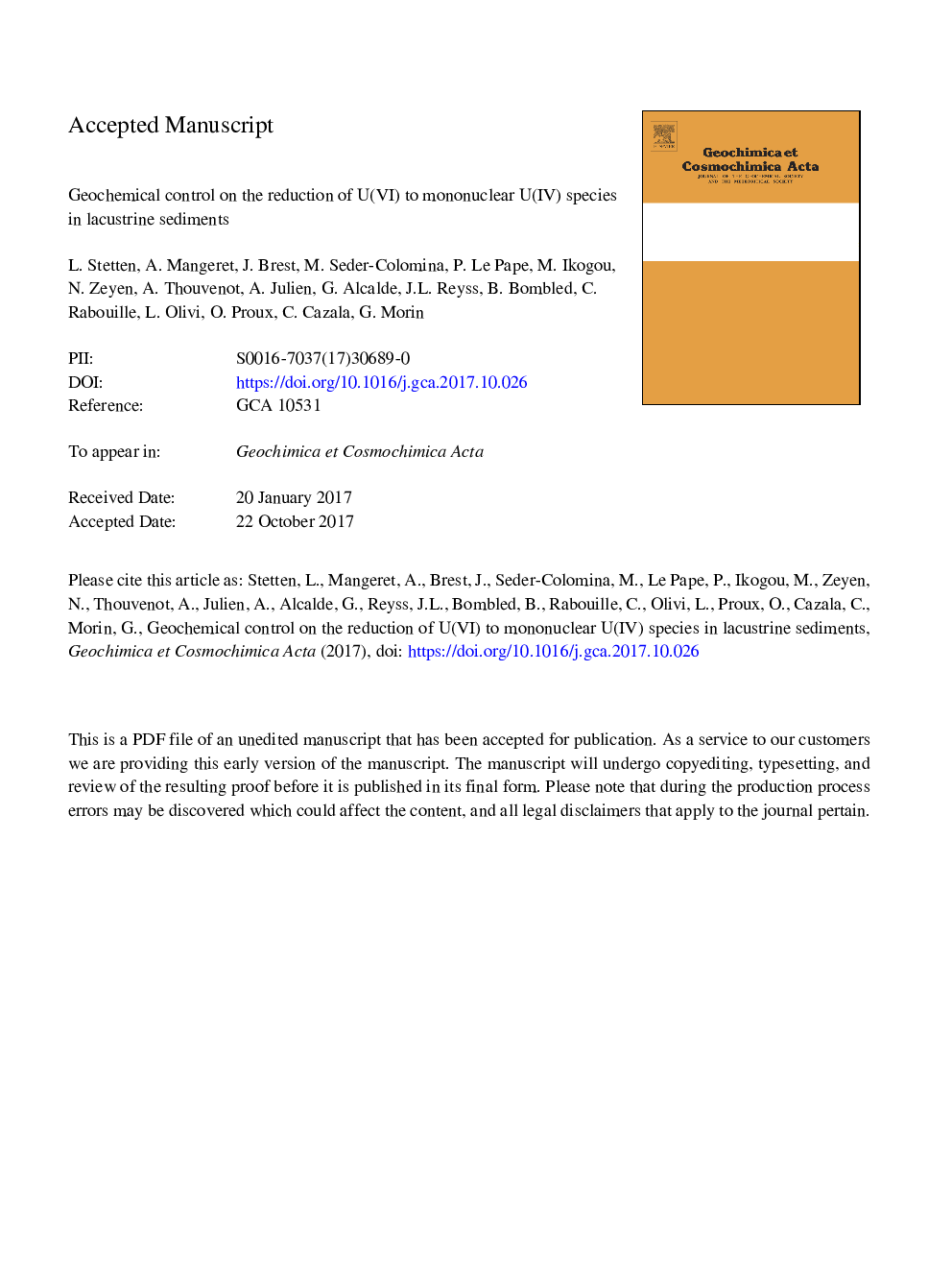| کد مقاله | کد نشریه | سال انتشار | مقاله انگلیسی | نسخه تمام متن |
|---|---|---|---|---|
| 8910938 | 1637935 | 2018 | 38 صفحه PDF | دانلود رایگان |
عنوان انگلیسی مقاله ISI
Geochemical control on the reduction of U(VI) to mononuclear U(IV) species in lacustrine sediments
دانلود مقاله + سفارش ترجمه
دانلود مقاله ISI انگلیسی
رایگان برای ایرانیان
کلمات کلیدی
موضوعات مرتبط
مهندسی و علوم پایه
علوم زمین و سیارات
ژئوشیمی و پترولوژی
پیش نمایش صفحه اول مقاله

چکیده انگلیسی
Contaminated systems in which uranium (U) concentrations slightly exceed the geochemical background are of particular interest to identify natural processes governing U trapping and accumulation in Earth's surface environments. For this purpose, we examined the role of early diagenesis on the evolution of U speciation and mobility in sediments from an artificial lake located downstream from a former mining site. Sediment and pore water chemistry together with U and Fe solid state speciation were analyzed in sediment cores sampled down to 50â¯cm depth at four locations in the lake. These organic-rich sediments (â¼12% organic C) exhibited U concentrations in the 40-80â¯mgâ¯kgâ1 range. The sediment columns were anoxic 2-3â¯mm below the sediment-water interface and pore waters pH was circumneutral. Pore water chemistry profiles showed that organic carbon mineralization was associated with Fe and Mn reduction and was correlated with a decrease in dissolved U concentration with depth. Immobilization of U in the sediment was correlated with the reduction of U(VI) to U(IV) at depth, as shown by U LIII-edge XANES spectroscopic analysis. XANES and EXAFS spectroscopy at the Fe K-edge showed the reduction of structural Fe(III) to Fe(II) in phyllosilicate minerals with depth, coincident with U(VI) to U(IV) reduction. Thermodynamic modeling suggests that Fe(II) could act as a major reducing agent for U(VI) during early diagenesis of these sediments, leading to complete U reduction below â¼30â¯cm depth. Shell-by-shell and Cauchy-Wavelet analysis of U LIII-EXAFS spectra indicates that U(VI) and U(IV) are mainly present as mononuclear species bound to C, P or Si ligands. Chemical extractions confirmed that â¼60-80% of U was present as non-crystalline species, which emphasizes that such species should be considered when evaluating the fate of U in lacustrine environments and the efficiency of sediment remediation strategies.
ناشر
Database: Elsevier - ScienceDirect (ساینس دایرکت)
Journal: Geochimica et Cosmochimica Acta - Volume 222, 1 February 2018, Pages 171-186
Journal: Geochimica et Cosmochimica Acta - Volume 222, 1 February 2018, Pages 171-186
نویسندگان
L. Stetten, A. Mangeret, J. Brest, M. Seder-Colomina, P. Le Pape, M. Ikogou, N. Zeyen, A. Thouvenot, A. Julien, G. Alcalde, J.L. Reyss, B. Bombled, C. Rabouille, L. Olivi, O. Proux, C. Cazala, G. Morin,